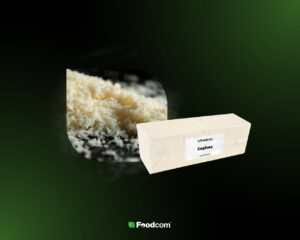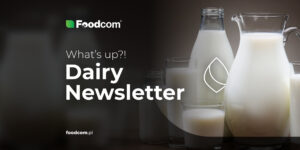- Australian processors are introducing record increases in milk purchase prices from July 1.
- GLP-1 drugs are reducing demand for fatty and sweetened dairy products, promoting protein alternatives.
- Canada is introducing regulations to protect the milk, poultry, and egg markets from trade concessions.
- Demand for milk powders and whey is falling on the European market, with fat prices remaining stable.
Welcome Partners!
Welcome back to our newsletter!
The dairy market is not quiet in the run-up to the summer. While Europe is facing a decline in milk production and weak demand for powders and whey, fat prices remain high thanks to high cream prices. Outside Europe, global trends – from rising milk prices in Australia to structural changes in Canada – are changing the competitive landscape. At the same time, changing consumer habits due to the use of GLP-1 drugs could significantly impact demand for dairy products in the coming years. Here’s what you need to know this week.
Scroll down for detailed market data and forecasts.
Milk powder
The European SMP market continues to face downward pressure on prices. Plentiful supply combined with limited export demand has resulted in a decline in spot transactions, with bids falling as low as 2300 EUR/MT. Premium brands maintain a slight price advantage, reaching levels as high as 2400 EUR/MT. Forward contracts for Q3 are being negotiated cautiously, reflecting the uncertainty of global demand, particularly in Asia.
The customised feed SMP market is following a similar trajectory. Wholesale supplies for July and August are reported in the 2350-2400 EUR/MT DAP Western Europe range. Reduced demand from the calf sector, due to high meat prices and structural changes in livestock farming, is limiting demand for milk powder for feeding young animals.
Cheese
The European cheese market continues to show signs of cautious stabilisation, although some categories are starting to feel the pressure. Retail demand for traditional products such as gouda and edam remains stable, preventing prices from falling significantly. Offers for these products are currently in the range of 4250-4350 EUR/MT for Gouda and 4250-4300 EUR/MT for Edam.
Mozzarella, on the other hand, is facing lower export demand, which is reflected in more competitive prices on European markets. Recent bids have been in the 4250-4300 EUR/MT range, with minor downward adjustments due to reduced buying activity in international markets, particularly evident following the weaker performance of recent global dairy trade events.
Market participants are also seeing a moderate increase in stock levels of some cheese categories, notably mozzarella and younger Gouda cheese, although producers continue to discipline production to avoid oversupply. There are no signs of aggressive price reductions by producers at this stage, but buyers remain cautious, especially for exports.
Seasonally warmer weather may continue to affect milk intake, which could translate into less raw material available for cheese production in the coming months – a factor that could stabilise prices despite the current export challenges.
Fats
The European butter market remains resilient, with prices stabilising at 7300-7400 EUR/MT for standard 25kg milk blocks. Smaller German formats are trading at slightly higher prices, reaching as high as 7500 EUR/MT. Increased cream prices, supported by a seasonal decline in milk fat content, continue to underpin the market. Buyers appear cautious, showing limited willingness to transact at higher prices and awaiting possible price adjustments. However, availability remains limited enough to maintain current price levels.
The market for anhydrous milk fat is stable, with no significant changes reported.
Fluids
The liquid dairy market remains supported by limited raw material availability and seasonal weather conditions.
Cream prices remain stable in the 8600-8700 EUR/MT range, reflecting steady demand and lower milk fat yields in the warmer months. Buyers continue to have limited choice of suppliers, which contributes to stable price levels in the European market.
SMC prices vary according to origin, with German products typically sold at 1900-2000 EUR/MT FCA, while French origin products are available at slightly lower prices, around 1700-1850 EUR/MT FCA. Availability remains limited in some regions, keeping the market balanced despite weak demand in the feed and powder sectors.
With the end of the seasonal production peak in Europe, raw milk volumes continue to decline. Hot weather in key dairy regions and structural challenges in the livestock sector are further limiting milk procurement. Spot prices remain stable as processors compete for available volumes. Long-term supply concerns are becoming more apparent, driven by the reduction in the young cattle population and ongoing demographic changes in the European agricultural sector.
Whey powder
The whey powder market remains under pressure in Europe. Food-grade SWP is trading between 1000–1050 EUR/MT, with feed-grade levels slipping further to 800–850 EUR/MT. Despite steady cheese production supporting raw material supply, limited demand from key export destinations, especially Asia, continues to weigh on prices.
For Q3 deliveries, feed-grade SWP with DAP delivery into Northwest Europe is being negotiated at 850–870 EUR/MT, reflecting subdued market sentiment. The recent uptick in sweet whey concentrate prices suggests some substitution effect from higher protein markets rather than a broad-based recovery in whey demand.
Protein markets remain fragmented. European WPC80 prices have softened slightly, reflecting cautious buying and global trade uncertainties. Domestic product is offered around 12000 EUR/MT, with imported options from other regions occasionally trading at lower levels, although volumes remain limited.
WPI markets show signs of gradual normalization. Prices are holding within the 19500–20000 EUR/MT range, with most Q3 requirements already covered. Reduced production output from manufacturers, aimed at stabilizing price levels, is helping to prevent a more significant market correction.
The European permeate market continues to feel the effects of weaker export demand and competitive global pricing, with food-grade product trading between 750–800 EUR/MT. Domestic demand has not been sufficient to counterbalance the shift in global trade flows.
Lactose prices remain stable at elevated levels, around 1250–1300 EUR/MT. While some purchasing activity for Q3 has concluded, the market remains sensitive to fluctuations in global demand, particularly from Asian markets.
What’s new?
Australia
Australian processors have announced significant increases in milk procurement prices that will come into effect on 1 July. Bulla Dairy Foods has offered a record AUD 9.70 per kilogram of milk on a solids (MS) basis, with other giants such as Saputo and Bega Cheese offering rates in the AUD 8.40-9.20/kg MS range. This is a big increase from last season, when prices hovered around AUD 8/kg MS. The increases are intended to help farmers cope with rising costs and keep them in business, but could also translate into higher prices for dairy products in the shops.
Global
GLP-1 formulations, originally used to treat diabetes and obesity, are increasingly able to change eating habits, with users giving up fatty, sweet and salty foods, hitting processed dairy products such as ice cream, ripened cheese and sweetened yoghurt hard. Studies show that the credit for these medicines and the drastic reduction in calories (by up to 20 per cent), results in a drop in demand for high-fat products; forecasts suggest a 4 per cent drop for things like dairy desserts and fatty sauces by 2035. – while skimmed milks, whey and protein products are gaining in popularity. Analysts recommend betting on low-fat milk, unsweetened variants and retrofitting product portfolios with protein-protected value – unpopular companies risk falling market share and farmers can modify their farms to produce more protein milk rather than fatty milk.
North America
The Canadian Parliament unanimously passed Bill C-202, which prohibits the government from making concessions on market access for milk, poultry and eggs during trade negotiations without prior parliamentary approval. The new law aims to protect the supply management system in these sectors, which has stabilised prices and incomes for domestic producers for years. Farm organisations, including Dairy Farmers of Canada, have welcomed the passage of the law, highlighting its role in defending the domestic market. However, critics warn that it could hinder Canada’s ability to conclude future trade agreements such as USMCA, CETA and CPTPP. The bill now awaits the Governor General’s formal signature.
![The dairy market under pressure: decisive price changes and global trends worth paying attention to! [273th edition of the DAIRY Newsletter] The dairy market under pressure: decisive price changes and global trends worth paying attention to! [273th edition of the DAIRY Newsletter]](https://foodcom.pl/wp-content/uploads/2023/08/Foodcom_Newsletter_Dairy-1520x760.jpg)






